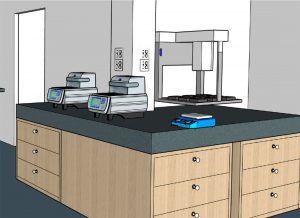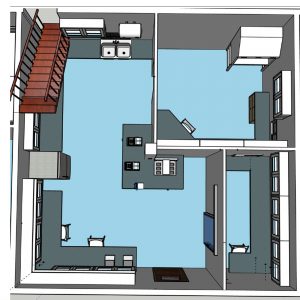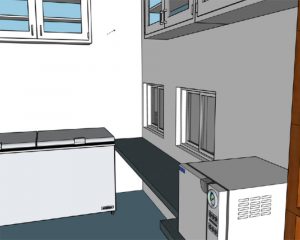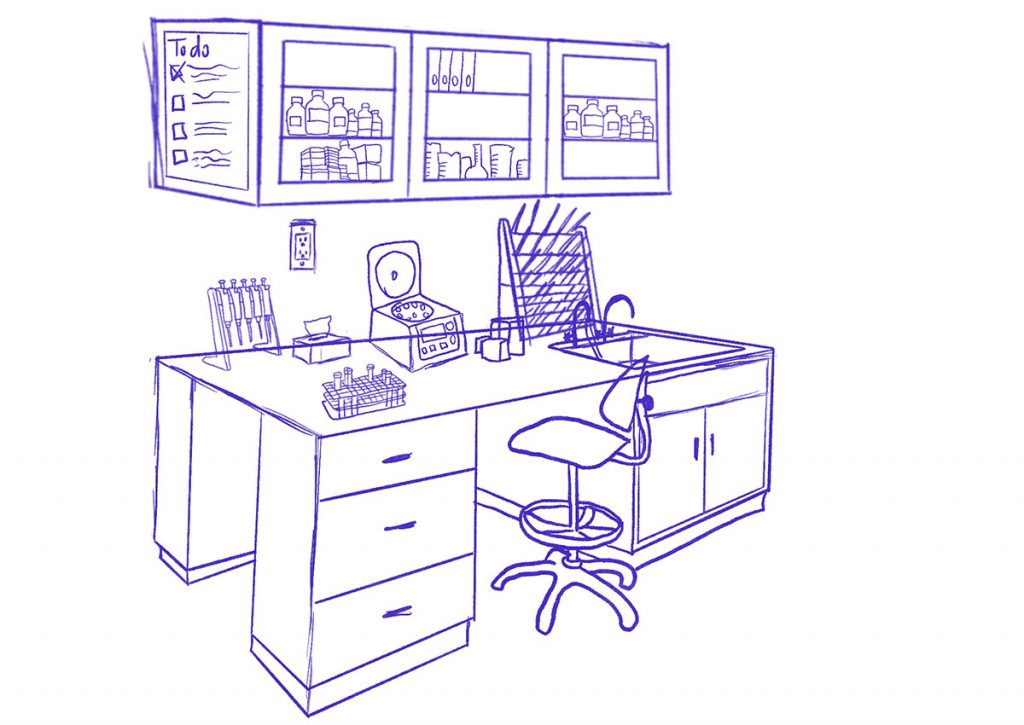LAYOUT & DESIGN
OPERATIONS
Running Your Lab
So you set up your lab - now what?
A GOAL of the ISL initiative is to build from existing local structures, by adapting spaces rather than creating new infrastructure from scratch. This will result in laboratories taking a variety of forms; however, it is still possible to adhere to basic laboratory design and layout principles with a little individuality.
How to Use Space
Compartmentalisation
The primary reason behind compartmentalizing work spaces is for biosecurity and to avoid contamination



Separate designated spaces that are fundamental for molecular laboratory work. This has the following advantages:
1. To avoid contamination. Contamination in a molecular laboratory is not visible to the naked eye, it shows up in the results and can completely confound interpretation of data, which leads to wasted time and resources.
2. To protect personnel. Separating work with biohazardous materials from spaces where personnel spend lots of time without PPE is vital.
3. To reduce congestion. Designated spaces should be separate rooms that are adjacent to each other, but if in a small laboratory, create spaces in a single room with tape and signage.
In this case, “clean” refers to the absence of any biological sample or DNA/RNA extraction, or PCR product – nor is it allowed to enter this space with PPE that has been used in other designated spaces. If possible, it is recommended to install a laminar flow cabinet with UV-light, within which clean reagents are manipulated. A small freezer may be located in this area for REAGENTS ONLY.
This space is designated exclusively for DNA/RNA extraction processes and is the only place in which any kind of crude sample may be opened. A freezer may be located in this area for samples that are in active use
This space has a sink + drying area, and numerous other counters on which reside basic laboratory equipment. Subdividing counters to contain a gel electrophoresis area, PCR (i.e. thermo-cycler area), and a desk area for laboratory personnel is recommended. It is also recommended to have one or more PCR prep cabinets (laminar flow hood with UV sterilization light) within which sample DNA/RNA template and PCR template are used. This is an appropriate place for a general purpose freezer or refrigerator.
This space is where autoclaving of consumables and reusable materials occurs. Autoclaves produce steam and therefore should have adequate clearance on all sides and be in a room that has some ventilation. In addition, it is useful to have a drying oven in this area and some storage shelving. Although some autoclaves have a drying function, it is quicker to move items out of the autoclave and into the oven where they dry quickly while the autoclave is reloaded with other materials. Much heat is generated by the autoclave and the oven, consider using an un-airconditioned area if overall laboratory energy consumption and space is limited.
This area is where field samples are received and stored until needed for analysis. Counters for organizing newly arrived sample, and freezers (-20 ºC for DNA applications) and -80 ºC (for RNA applications) are need in this area. It is also useful if this space is closely connected to the Extraction space.
How to Use Space
Design Factors
Every aspect of a laboratory is customisable, but how do you choose?

Laboratory work takes place at standing counters, high chairs or stools may be purchased to help with extended work times.
Various materials can be used for countertops, the standards for academic research laboratories are:
- Solid phenolic resin (AKA Solid Phenolic Compact and similar to the commonly known Trespa material) – high-pressure solid resin composite material
- Epoxy resin – the most commonly used work surface material for scientific and laboratory applications.
This is often too expensive or unavailable in situ, and more practical alternatives that we have seen include:
- Dark marble slab
- Composite wood boards with water proof coating
- Cement with a black enamel surface coating
- Wooden table covered with sheet metal
ISL laboratories do not typically use highly dangerous or corrosive substances, and major considerations for counter type tends to be accessibility, durability, and cost.
| Sizing | inches | centimeters |
| Length | variable | variable |
| Depth | 24 – 30 | 60 – 76 |
| Height | 36 | 91.5 |
Laboratory desks are typically made of the same material as counters for aesthetic purposes, although we would advise against this for highly expensive counter types. Laboratory work does not take place at desks, instead this is a dedicated space where laptops, notebooks, hard drives, office materials, and other organizational content is kept. The desk/counter is lower for more prolonged comfort while sitting. This is where researchers and technicians spend time planning work and analyzing data. Desk space is optional, but tends to be more comfortable for personnel that will work in the laboratory full-time.
| Sizing | inches | centimeters |
| Length | variable | variable |
| Depth | 24 – 30 | 60 – 76 |
| Height | 29 – 30 | 74 – 76 |
Overhead counters should be placed above most counters to maximize storage capacity and help with overall organization. Exceptions should be made for wall-mounted air conditioners and windows (for natural light). Framed glass/plexiglass swinging doors are ideal, so that the contents inside are visible. Not that vertical position is in relation to the counters, not the floor.
| Sizing | inches | centimeters |
| Length | variable | variable |
| Depth | 12 – 14 | 60 – 76 |
| Height from countertop | 20 | 30.5 – 35.5 |
| Vertical shelf spacing | 12 | 30.5 |
Beneath some of the counters AND inbetween the most logical standing or sitting work places, storage drawers should be installed to maximize storage capacity and to help with overall organization.
| Sizing | inches | centimeters |
| Width | 12 – 18 | 30.5 – 50 |
| Depth | 18 – 22 | 50 – 56 |
| Drawer height | 6 – 8 | 12 – 21 |
| Cumulative height | Flush with counter | Flush with counter |
One or more metal cabinets are needed to store liquids that are classified as flammable / corrosive / peroxide forming. These liquids must be stored in physically separated spaces. Hence one cabinet with doors to separate compartments or multiple smaller cabinets should suffice. The cabinet should have shelfs with approximately 14in (36cm) of vertical clearance, to accommodate unusually tall jugs and containers. The cabinet can be made to fit underneath standing counters with swing doors (not shelves), as a way to save space. It is also a good idea to equip these cabinets with a locking mechanism.
The main laboratory area needs a wide wash sink, ideally with two faucets. Drying racks and trays can be installed next to the sink and on the wall behind the sink so that water collects and drains into the sink. Underneath the sink area should be a cabinet for storing cleaning products. The cleaning products can be stored in trays, on the floor, underneath the sink (shelving is not recommended for this space). Ideally the cabinet frame is made of metal and should have swing doors.
Windows to the outside are not required for a laboratory space, and may even be ill-advised for areas with intense solar radiation and limited energy production. However, when possible, some windows that allow for natural light in the lab are beneficial to personnel working inside. It is necessary to equip all exterior windows with curtains or blinds, since some laboratory procedures require darkness.
An access window between two designated spaces is also helpful in many contexts. For example, sliding windows are useful to pass samples from the STORAGE ROOM into the EXTRACTION ROOM, or to pass autoclaved materials from the STERILIZATION ROOM to the CLEAN ROOM.
Strong, hinged doors to the exterior of the laboratory should have a reliable locking mechanism. Access to the laboratory must be restricted to trained or approved personnel. Appropriate signage should be fixed to the exterior of the door.
Inside a laboratory with multiple rooms, consider sliding glass doors as an alternative to hinged doors, which makes better use of limited spacing.
Broad overhead room lighting is recommended, preferably LED or good quality tube bulbs that do not require frequent replacement. Lighting from a single source that creates shadows will make laboratory procedures very difficult.
Overhead fans should NOT be installed in laboratories because they increase the probability of human contamination, sample cross contamination, or PCR product contamination. They also accumulate and then spread dust and other airborne particles all over.
If possible, avoid open-air laboratories, though this may not be possible if air conditioning is unavailable.
Before counters, cabinets, and shelving are fixed in place, it is a good idea to review the list of large equipment items that will be installed so that they will probably fit. These items include, but are not limited to, biosafety cabinets, PCR cabinets and laminar flow hoods, refrigerators, freezers, autoclave, drying oven, water purification system. All vendors provide a product specification sheet which gives the external dimensions of these materials. For any free-standing items, leave approximately 4-6 in(10 – 15 cm) of clearance above and around the sides.
Try to install certain other features to help your lab personnel:
- Hooks for laboratory coats for each designated space
- Hooks or shelving at main entrance to laboratory, for storage of personal items
- Dry erase or chalk boards
